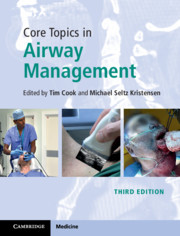Book contents
- Core Topics in Airway Management
- Core Topics in Airway Management
- Copyright page
- Contents
- Contributors
- Foreword
- Preface to the Third Edition
- Section 1 Airway Management: Background and Techniques
- Section 2 Airway Management: Clinical Settings and Subspecialties
- Section 3 Airway Management: Organisation
- Chapter 34 Departmental and Hospital Organisation
- Chapter 35 Training in Airway Management
- Chapter 36 Human Factors in Airway Management
- Chapter 37 Decontamination of Airway Equipment
- Chapter 38 Airway Management in a Respiratory Epidemic or Pandemic
- Index
- References
Chapter 36 - Human Factors in Airway Management
from Section 3 - Airway Management: Organisation
Published online by Cambridge University Press: 03 October 2020
- Core Topics in Airway Management
- Core Topics in Airway Management
- Copyright page
- Contents
- Contributors
- Foreword
- Preface to the Third Edition
- Section 1 Airway Management: Background and Techniques
- Section 2 Airway Management: Clinical Settings and Subspecialties
- Section 3 Airway Management: Organisation
- Chapter 34 Departmental and Hospital Organisation
- Chapter 35 Training in Airway Management
- Chapter 36 Human Factors in Airway Management
- Chapter 37 Decontamination of Airway Equipment
- Chapter 38 Airway Management in a Respiratory Epidemic or Pandemic
- Index
- References
Summary
Human factors can be defined as the science of understanding of interactions among humans and other elements of a system, and how they can be adapted to improve performance and safety. Human factors issues were present in 40% of the cases of major complications in airway management in NAP4. Human factors issues can be considered in terms of ‘threats’ and ‘safeguards’. Threats increase the likelihood of the occurrence of an error that results in patient harm while safeguards help prevent this. Threats and safeguards in relation to human factors in airway management refer not only to ‘non-technical skills’ (e.g. situation awareness, teamwork) but also many other factors such as procedures, staffing and the physical environment in which airway management is conducted. Proper attention to human factors related issues contributes to both the prevention and effective management of airway emergencies and requires that these issues are considered as part of an integrated approach at the level of the individual, team, environment and organisation as part of routine airway care – not only when an emergency arises.
Keywords
- Type
- Chapter
- Information
- Core Topics in Airway Management , pp. 305 - 315Publisher: Cambridge University PressPrint publication year: 2020

